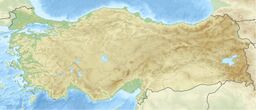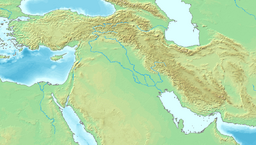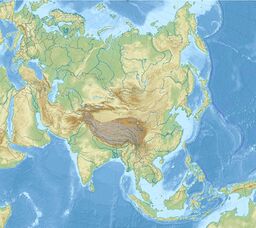Earth:Karaca Dağ
From HandWiki
Short description: Mountain in Turkey
| Karaca Dağ | |
|---|---|
 Karapınar Field, looking east on Karaca Mountains in 2012 | |
| Highest point | |
| Elevation | 1,957 m (6,421 ft) |
| Coordinates | [ ⚑ ] : 37°40′12″N 39°49′48″E / 37.67°N 39.83°E |
| Geography | |
| Parent range | Taurus Mountains |
| Geology | |
| Mountain type | Shield volcano |
| Last eruption | Unknown |
Karaca Dağ is a shield volcano located in southeastern Turkey,[1] near Diyarbakır.
It was also known as "Mount Masia",[2] Which in turn was used to give the title of an iris found on the mountain, as Iris masia.[3]
Water Resources
- The streams originating from Karaca Dağ are the most significant water sources in the region. There are also a large number of springs on the southern side of Karaca Dağ and in the northern parts of the region.[4]
- Sanliurfa and specifically the Karaca Dağ area are popular for its spring waters which are sold as bottled water to the world.[5]
- The river Khabur originates from a source at the southwestern slope[6][circular reference] of the Karaca Dağ and flows into the Euphrates further south at Circesium.
- The river Euphrates does not only originate at the confluence of the Karasu river (north) and the Murat river (northeast) in the Armenian highlands of northeastern Turkey, but in its originally predominant source from the northwestern slope of the Karaca Dağ, through what is known today as the Camcayi Creek.[7]
- The river Tigris does not only originate 74 kms (45 miles) northeast of Diyarbakir and flows through the same city, but it was formerly fed through at least 4 sources from the southeastern slope of the Karaca Dağ, located 33 km (20 miles) southwest of Diyarbakir.[8]
Agricultural History
- Researchers at the Max Planck Institute for Plant Breeding Research in Cologne[9] discovered that the genetically common ancestor of 68 contemporary types of cereal still grows as a wild plant on the slopes of Mount Karaca (Karacadag).[10][11]
- The region is known as the place of origin of different major crops including lentils and chickpeas.[12]
- Karaca Dağ today can be described as a rice mine. Its soil can be described as a layer of soil composed of volcanic lava and deep stone layers, which is highly rich in terms of organic compounds.[13]
Vegetation
- While Karaca Dağ was covered by forest vegetation until 40-50 years ago, today, human activities threaten the plant diversity at Karaca Dağ.[14]
See also
- List of volcanoes in Turkey
- Thamanin
References
- ↑ "Karaca Dag". Smithsonian Institution. https://volcano.si.edu/volcano.cfm?vnum=213011.
- ↑ Phillips, Roger; Rix, Martyn (1991). Perennials Vol. 1. Pan Books Ltd.. p. 216. ISBN 9780330327749.
- ↑ Pries, Bob (28 November 2013). "(SPEC) Iris masia Stapf ex Fos.". wiki.irises.org (American Iris Society). http://wiki.irises.org/bin/view/Spec/SpecMasia. Retrieved 24 November 2014.
- ↑ "New Pre-Pottery Neolithic sites and cult centres in the Urfa Region.". Documenta Praehistorica (University of Harran) 40: 291–304. 2013. doi:10.4312/dp.40.23. https://journals.uni-lj.si/DocumentaPraehistorica/article/view/40.23/817#page=4. Retrieved 2023-07-01.
- ↑ "Karacadağ Doğal Kaynak Suyu.". https://www.karacadagsu.com/en/anasayfa.
- ↑ "Syria 2005 CIA map.jpg". 26 October 2013. https://en.wikipedia.org/wiki/Khabur_(Euphrates)#/media/File:Khabur_River_in_Syria_2004_CIA_map.jpg.
- ↑ "Locations Of Bible History.". Fit For Faith Ministries. June 2021. https://www.google.com/maps/d/u/1/edit?mid=13oAbhcqZMx6Ae6wajYAkh929R0eexg6_&usp=sharing.
- ↑ "MERIT Hydro Visualization and Interactive Map.". Google Earth Engine. https://meritdataset.users.earthengine.app/view/merit-hydro-visualization-and-interactive-map.
- ↑ Max Planck Institute for Breeding Research
- ↑ Heun, Manfred (November 1997). "Site of Einkorn Wheat Domestication Identified by DNA Fingerprinting". Science 278 (5341): 1312–1314. doi:10.1126/science.278.5341.1312. Bibcode: 1997Sci...278.1312H. http://www.ndsu.nodak.edu/instruct/mcclean/plsc731/homework/papers/huen%20et%20al%20-%20site%20of%20einkorn%20wheat%20domestication%20identified%20by%20DNA%20fingerprinting.pdf. Retrieved 2010-08-29.
- ↑ McCarter, Susan Foster (2007). Neolithic. New York: Routledge. p. 34. ISBN 0-415-36414-0. https://www.google.com/books/edition/Neolithic/-H_29C0qolgC?hl=en.
- ↑ "Biodiversity of Turkey: Contribution of Genetic Resources to Sustainable Agriculture and Food Systems.". Food and Agriculture Organization of the United Nations. https://www.fao.org/3/CA1517EN/ca1517en.pdf#page=15.
- ↑ "Southeastern Anatolia's super rice ready to adorn dinner tables.". Daily Sabah. 2 November 2017. https://www.dailysabah.com/food/2017/11/02/southeastern-anatolias-super-rice-ready-to-adorn-dinner-tables.
- ↑ A syntaxonomical and synecological research on the steppe vegetation of the Karacadağ Mountain.. University of Harran. doi:10.3406/ecmed.2010.1375. https://www.persee.fr/doc/ecmed_0153-8756_2010_num_36_1_1375. Retrieved 2023-07-01.
 |




